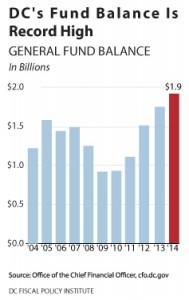The District ran a surplus of over $200 million last year, which offers a great opportunity to invest in things that will help DC residents and make the city stronger, such as replacing the DC General shelter or buying more technology for schools. The mayor and council will need to take special action, however, because current law requires every dollar of surplus to be saved in reserves. At a time when the city’s savings are at a record level and resident needs are great, using a portion of the surplus for other needs is a prudent move.
Some of the latest surplus cannot be used, such as funds set aside for the new soccer stadium. But the mayor and council could decide to use other portions. For example, $48 million of the surplus is earmarked for a “cashflow” reserve that reduces the District’s need to borrow in the middle of the year in between major tax collections. Yet the benefits of adding to this reserve are modest, because short-term borrowing currently costs the city less than $1 million a year. Rather than adding to this reserve, the funds could be spent to help residents.
DC’s leaders also could examine the city’s multiple special funds, which contributed $50 million to the surplus. Some of these funds may have more resources than needed for their specified purposes.
These steps could free up millions of dollars for a range of one-time investments, such as helping families facing eviction or utility shutoffs, helping moderate-income residents buy their first home, or adding to library collections.
Some people may express concern about spending surplus funds, but consider this:
- Even before the latest surplus, the city’s savings (its fund balance) were the highest on record.
- The city has saved almost $1 billion in surplus funds in the last three year.
- The District’s fund balance is larger than in most states. Only seven states have larger balances than DC when measured as a share of its budget.
- When the District had substantial surpluses in the mid-2000s, then-Mayor Williams used as much as $500 million per year in surplus funds for a variety of purposes.
A balanced approach to the year-end surplus makes sense. Setting aside huge amounts of city resources in savings, when savings already are sizable, is a wasted opportunity to make investments that will improve the quality of life in the District.
To print a copy of today’s blog, click here.
